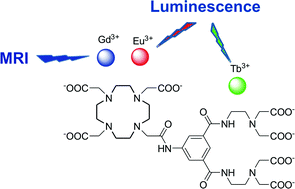Synthesis and characterization of dinuclear heterometallic lanthanide complexes exhibiting MRI and luminescence response
Abstract
A molecule bearing a macrocyclic

* Corresponding authors
a
Department for Physiology of Cognitive Processes, Max Planck Institute for Biological Cybernetics, Spemannstr. 38, Tübingen, Germany
E-mail:
goran.angelovski@tuebingen.mpg.de
Fax: +49 7071 601 919
Tel: +49 7071 601 916
b Department of Chemistry, Laboratory of Molecular Design and Synthesis, Katholieke Universiteit Leuven, Celestijnenlaan 200F, Leuven, Belgium
c Imaging Science and Biomedical Engineering, University of Manchester, Manchester, U.K
A molecule bearing a macrocyclic

 Please wait while we load your content...
Something went wrong. Try again?
Please wait while we load your content...
Something went wrong. Try again?
I. Mamedov, T. N. Parac-Vogt, N. K. Logothetis and G. Angelovski, Dalton Trans., 2010, 39, 5721 DOI: 10.1039/B925556G
To request permission to reproduce material from this article, please go to the Copyright Clearance Center request page.
If you are an author contributing to an RSC publication, you do not need to request permission provided correct acknowledgement is given.
If you are the author of this article, you do not need to request permission to reproduce figures and diagrams provided correct acknowledgement is given. If you want to reproduce the whole article in a third-party publication (excluding your thesis/dissertation for which permission is not required) please go to the Copyright Clearance Center request page.
Read more about how to correctly acknowledge RSC content.
 Fetching data from CrossRef.
Fetching data from CrossRef.
This may take some time to load.
Loading related content
